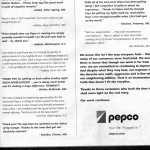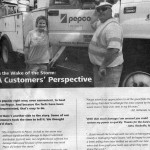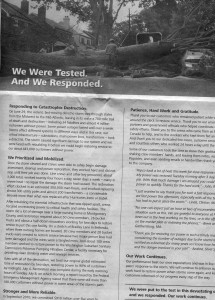Pepco really really wants you to believe a story
Well, faithful blog readers, I thought I was done writing about Pepco’s advertising efforts, but then I saw this nearly-full page ad in yesterday’s (Sunday, July 29) Washington Post (again, I had to scan it in two parts):
In case you can’t read the ad above, let me provide the content:
It’s popular right now, even convenient, to beat up on Pepco. And because the facts have been misrepresented, that’s easy to do.
But there’s another side of the story. Some of our customers too the time to tell it. We thought we’d share.
If I understand this correctly, Pepco is saying that government officials like Rep. Chris Van Hollen, the Montgomery County Council, DC Mayor Gray, the media, and customers who are complaining about Pepco’s dismal service are “beating up” on Pepco because the “facts have been misrepresented.” What facts is the ad alluding to? We know (we lived) the facts: 780,000 of Pepco’s customers lost power, and of those, most received power by July 4, five days after the storm. Other customers weren’t restored until July 6. Those are the facts on the ground and they have not been misrepresented.
Pepco is attempting to convince you that you are wrong if you believe the narrative that Pepco did not do enough to restore power during the derecho (which was exactly one month ago from the date of the ad). Instead, Pepco parades 17 customer testimonials that are praising Pepco’s performance (out of the 780,000 affected by the outage—that is an extremely meager 0.00217%).
The ad continues:
We know this isn’t the way everyone feels-that many of our customers were frustrated. We want them to know that though our work is far from over, we are committee to continuing to improve. And despite what they may hear, our response to the derecho was swift, aggressive and in line with our neighboring utilities. That is an inconvenient truth that doesn’t fit the storyline.
Thanks to the customers who took the time to shed some light on the real story.
So, Pepco is saying that it knows “some” customers are frustrated, but in essence, they have no right to feel that way because it doesn’t fit the Pepco storyline. The Pepco storyline (and that is exactly what it is, a story that Pepco tells itself) is that Pepco works hard and that people have no right to expect anything more from it. The 17 customers that they quote in the ad understand this “real story.”
Honestly, in my nearly 20-year marketing career, I have never seen something like this. It truly is a waste of advertising dollars (which Pepco customers are footing the bill for). To run an ad in the newspaper of record to tell customers that they are wrong to feel frustrated because they are being misguided by “misrepresented facts” is truly an outrage.
Again, Pepco’s communications department seems to be tone-deaf, and really really bad at advertising. Rule number one of advertising is that you don’t insult your customers.
Pepco management is desperate to improve its public perception. However, through these misguided and mismanaged advertising efforts, it is only hurting itself further.


